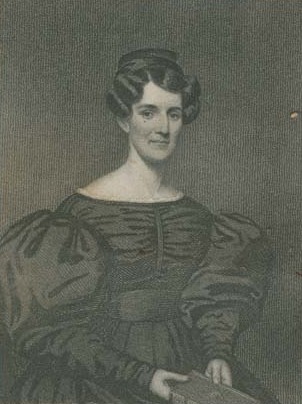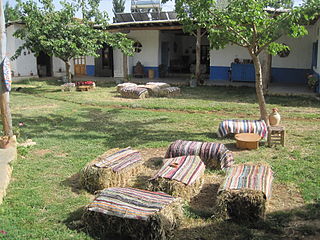
Khiam is a large town in the Nabatieh Governorate of Southern Lebanon.

Edward Robinson was an American biblical scholar known for his magnum opus, Biblical Researches in Palestine, the first major work in Biblical Geography and Biblical Archaeology, which earned him the epithets "Father of Biblical Geography" and "Founder of Modern Palestinology."

The Near East School of Theology (NEST), located in Beirut, Lebanon, is an interdenominational Reformed Protestant theological seminary serving Christian churches of the Middle East and North Africa, and also educates international students who have a special interest in Biblical and Islamic studies in a Middle Eastern context or those especially interested in the Ancient churches.
El Ain, Al Ain, or Ain is a village at an elevation of 1,000 metres (3,300 ft) on a foothill of the Anti-Lebanon Mountains in the Baalbek District of the Baalbek-Hermel Governorate, Lebanon. It is famous for agriculture and trade, located on the highway connecting Syrian borders and the Hermel area with Chtaura and Beirut.

Hisah is a northern Lebanese village in Akkar Governorate, close to the Syrian border. It is mostly inhabited by Alawites and Sunni Muslims.

Aabey, also spelled Abey, is a village located in Mount Lebanon, in Aley District of Mount Lebanon Governorate. It is located 22 km (14 mi) from Beirut and has an altitude of 800 m. It is bordered by Kfarmatta (South), Al Bennay (East), Damour (West), and Ain Ksour (North). It overlooks Damour and the capital Beirut and the sea can be seen from virtually any point in the village. Aabey contains the Dawdye college, Aabey Vocational School (Mihanye) etc.

The Galilee earthquake of 1837, often called the Safed earthquake, shook the Galilee on January 1 and is one of a number of moderate to large events that have occurred along the Dead Sea Transform (DST) fault system that marks the boundary of two tectonic plates; the African Plate on the west and the Arabian Plate on the east. Intensity assessments for the event were VIII (Damaging) on the Medvedev–Sponheuer–Karnik scale and VIII on the European Macroseismic Scale.
Rablah is a town in central Syria, administratively part of the Homs Governorate, located southwest of Homs. Just east of the border with Lebanon, nearby localities include al-Nizariyah to the southwest, Zita al-Gharbiyah to the northwest, al-Qusayr to the north, Zira'ah to the northeast and Hisyah to the east. According to the Central Bureau of Statistics (CBS), Rableh had a population of 5,328 in the 2004 census. Its inhabitants are predominantly Greek Catholics.

William McClure Thomson was an American Protestant missionary working in Ottoman Syria. After spending 25 years in the area he published a best-selling description of what he had seen in his travels. He used his observations as a means of illustrating and illuminating passages from the Bible.
Darbal is a Syrian village in the Qatana District of the Rif Dimashq Governorate. According to the Syria Central Bureau of Statistics (CBS), Darbal had a population of 2,049 in the 2004 census. Its inhabitants are predominantly Muslims.
Arnah is a Syrian village in the Qatana District of the Rif Dimashq Governorate. According to the Syria Central Bureau of Statistics (CBS), Arnah had a population of 3,146 in the 2004 census. Its inhabitants are predominantly Druze.
Bodai is a Lebanese town in Baalbek District, Baalbek-Hermel Governorate, situated west of the Litani River in the foothills of Mount Lebanon. Bodai is located 15 km northwest of the ancient city of Baalbek and 26 km from the Lebanese–Syrian border and is 90 kilometers (55.926 mi) away from the capital of Beirut. Bodai, which sits in the foothills of the Mount Lebanon range, has views across the Beqaa Valley toward the city of Baalbek, and the Anti-Lebanon range that divides Lebanon from Syria.
′Ataman, also spelled ′Atman, Athman, Osmane or Othman, is a village in southern Syria, administratively part of the Daraa Governorate, located 4 kilometers north of Daraa. Other nearby localities include al-Yadudah to the west, Tafas to the northwest, Da'el to the north, Khirbet Ghazaleh to the northeast, al-Ghariyah al-Gharbiyah to the east and al-Naimah to the southeast. According to the Syria Central Bureau of Statistics, Ataman had a population of 8,929 in the 2004 census.

Ghosta is a municipality in the Keserwan District of the Keserwan-Jbeil Governorate of Lebanon. It is located 36 kilometers north of Beirut. Ghosta's average elevation is 950 meters above sea level and its total land area is 461 hectares. Its inhabitants are predominantly Maronite Catholics.

Saadnayel is a town in the Bekaa Valley in the Zahlé District of Lebanon. It has a population of around 52,500, mostly Sunnis.

Sarah Lanman Smith was a 19th-century American Christian missionary, memoirist, and school founder. In 1835, she established the American School for Girls, which became the Lebanese American University.

Hibran, also spelled Hebran or Hubran, is a village in southern Syria, administratively part of the Suwayda Governorate, located south of Suwayda. According to the Syria Central Bureau of Statistics (CBS), Hibran had a population of 3,166 in the 2004 census.

Taanayel, also transliterated Tanayal, is a village located in the Zahlé District of the Beqaa Governorate in Lebanon.
Deir Jannine is a town in Akkar Governorate, Lebanon, close to the border with Syria.

The Kiepert maps of Palestine and Jerusalem were important scientific mappings of the region of Palestine and mappings of Jerusalem, initially published in 1841 by German cartographer Heinrich Kiepert as the maps accompanying Biblical Researches in Palestine, the magnum opus of the "Father of Biblical Geography", Edward Robinson.













